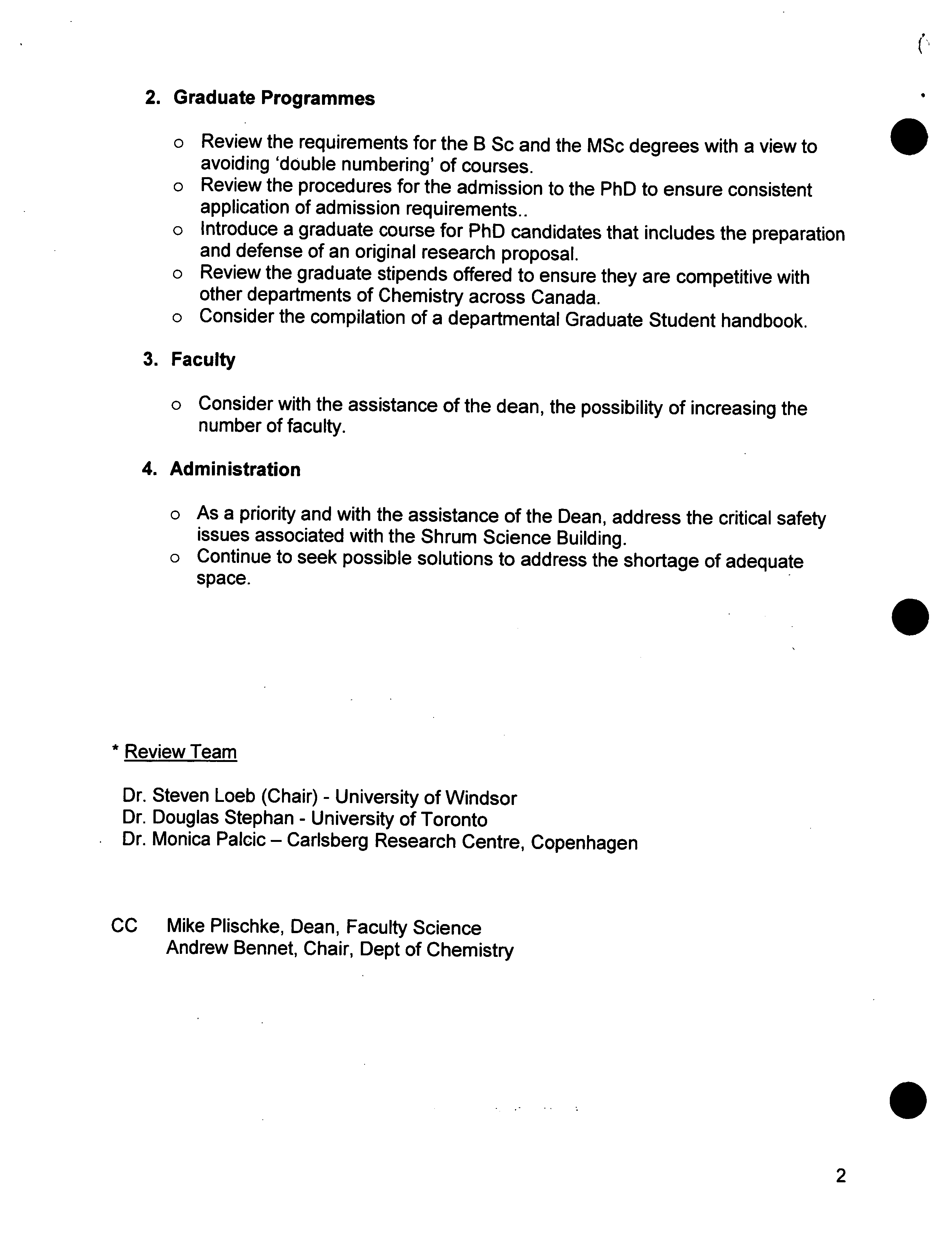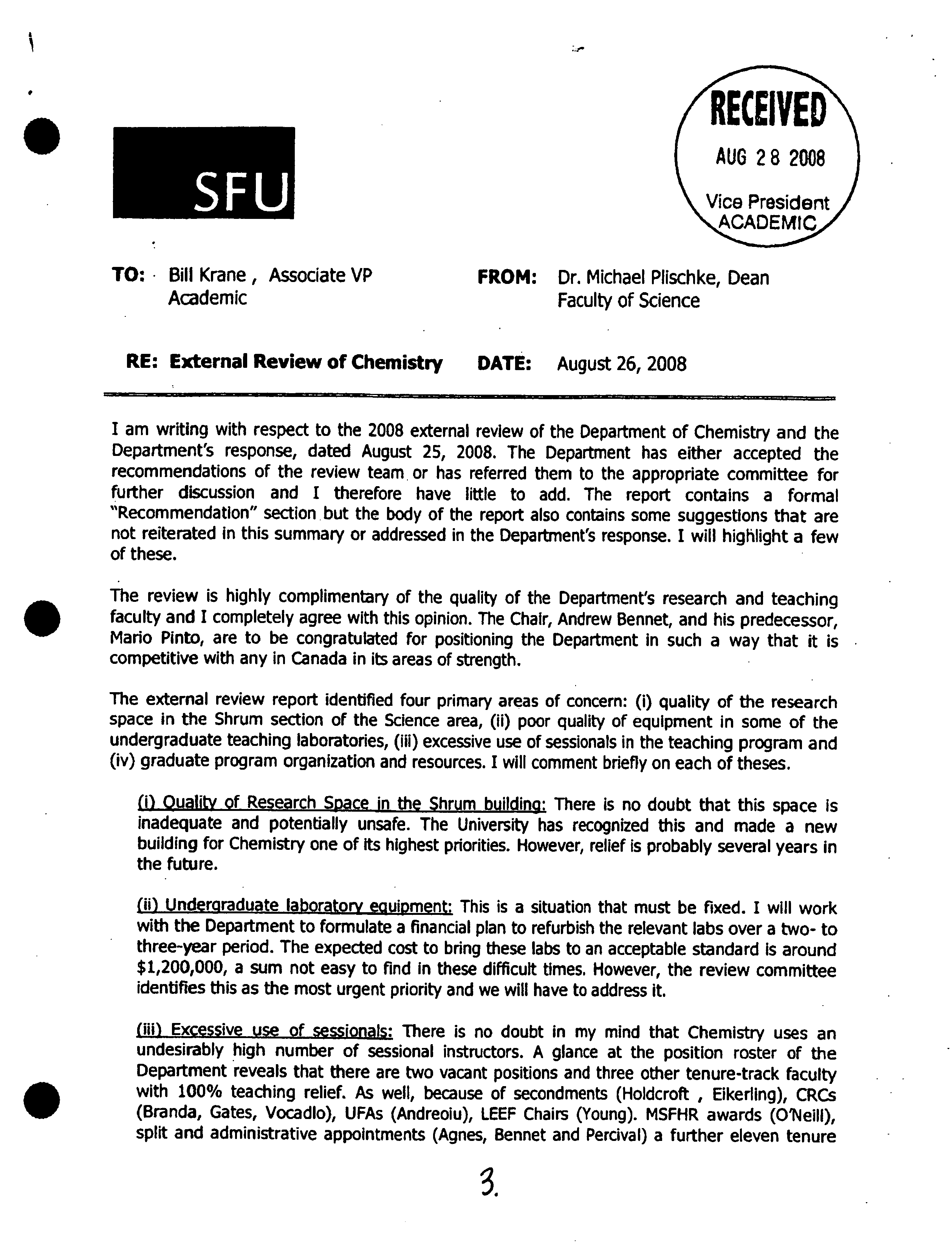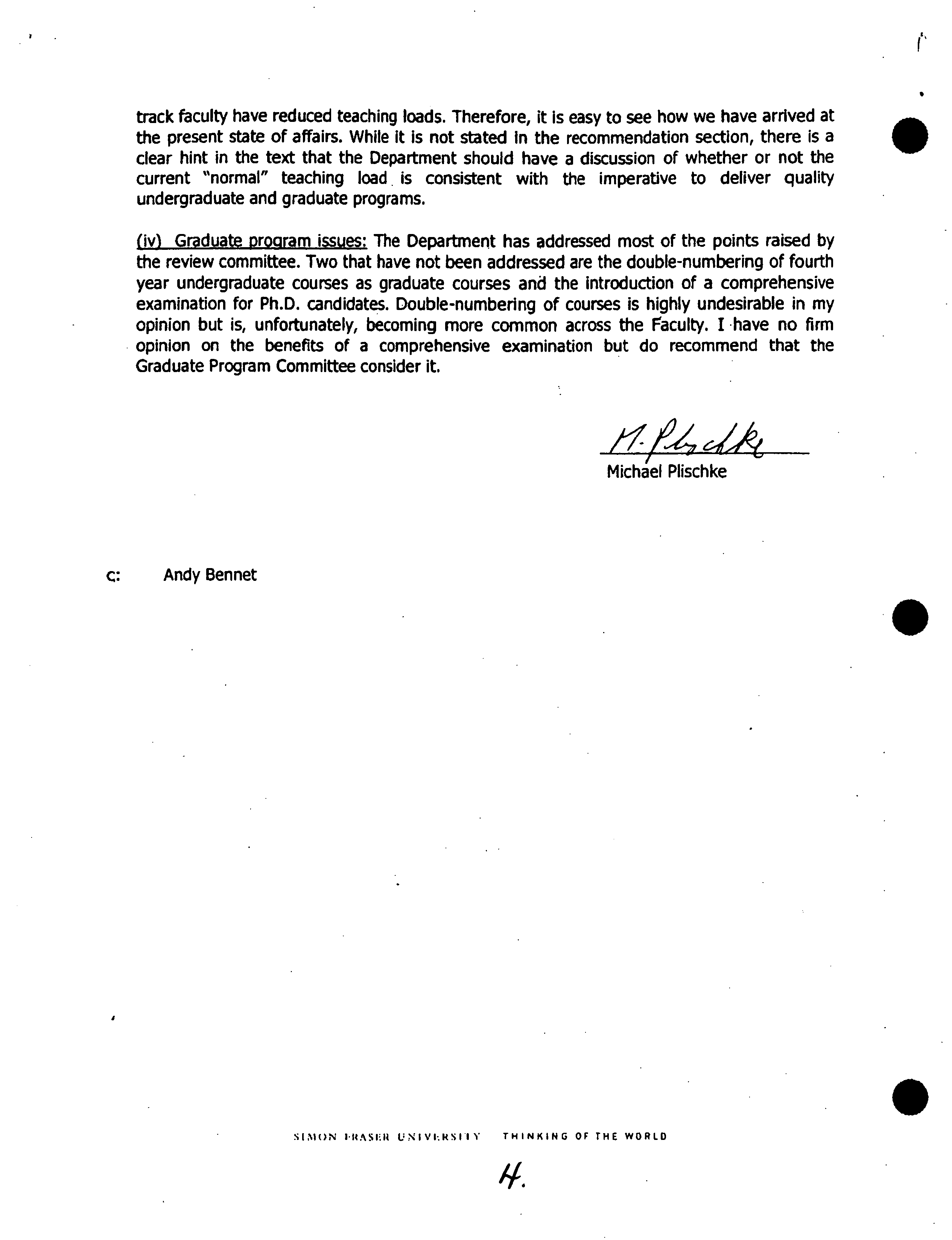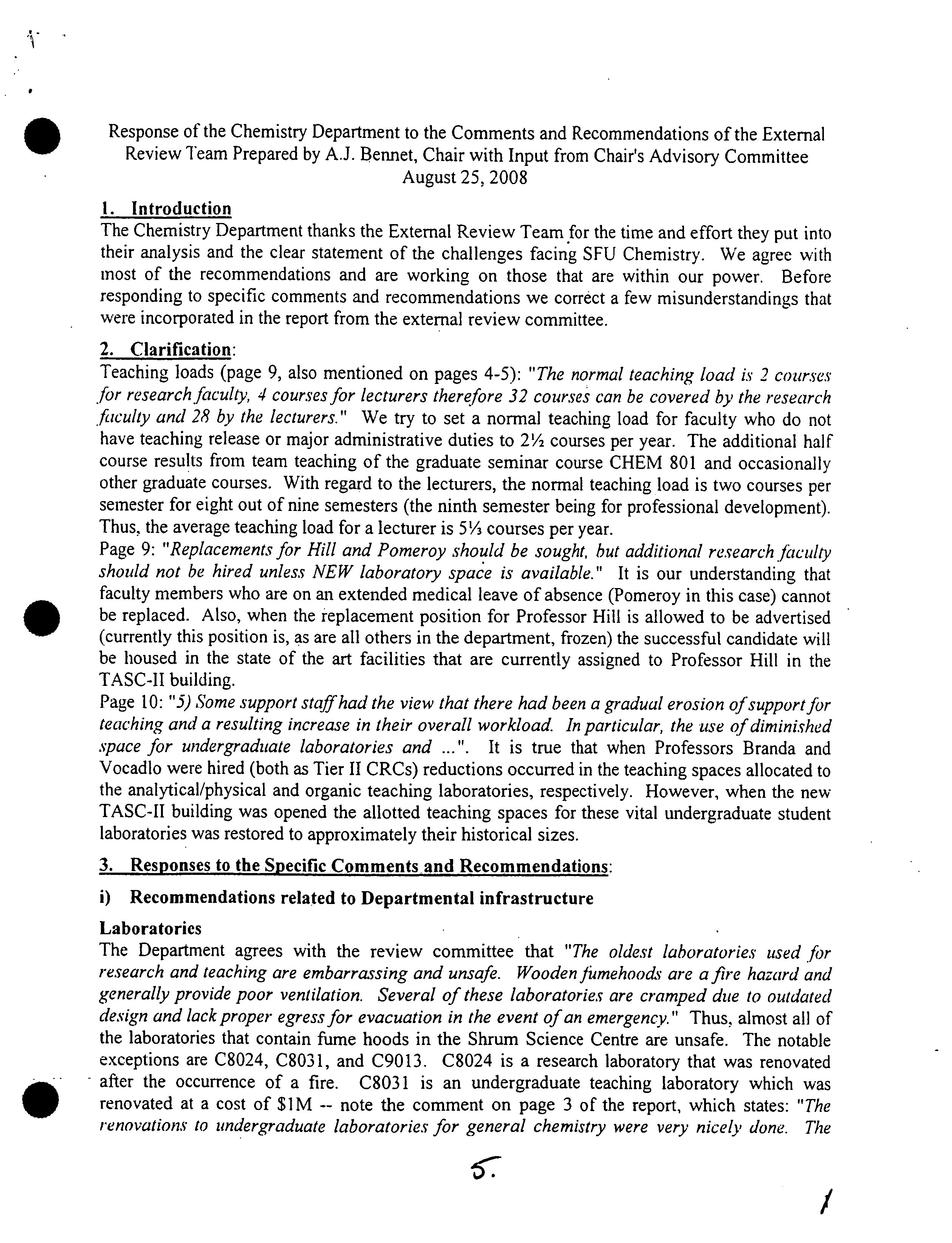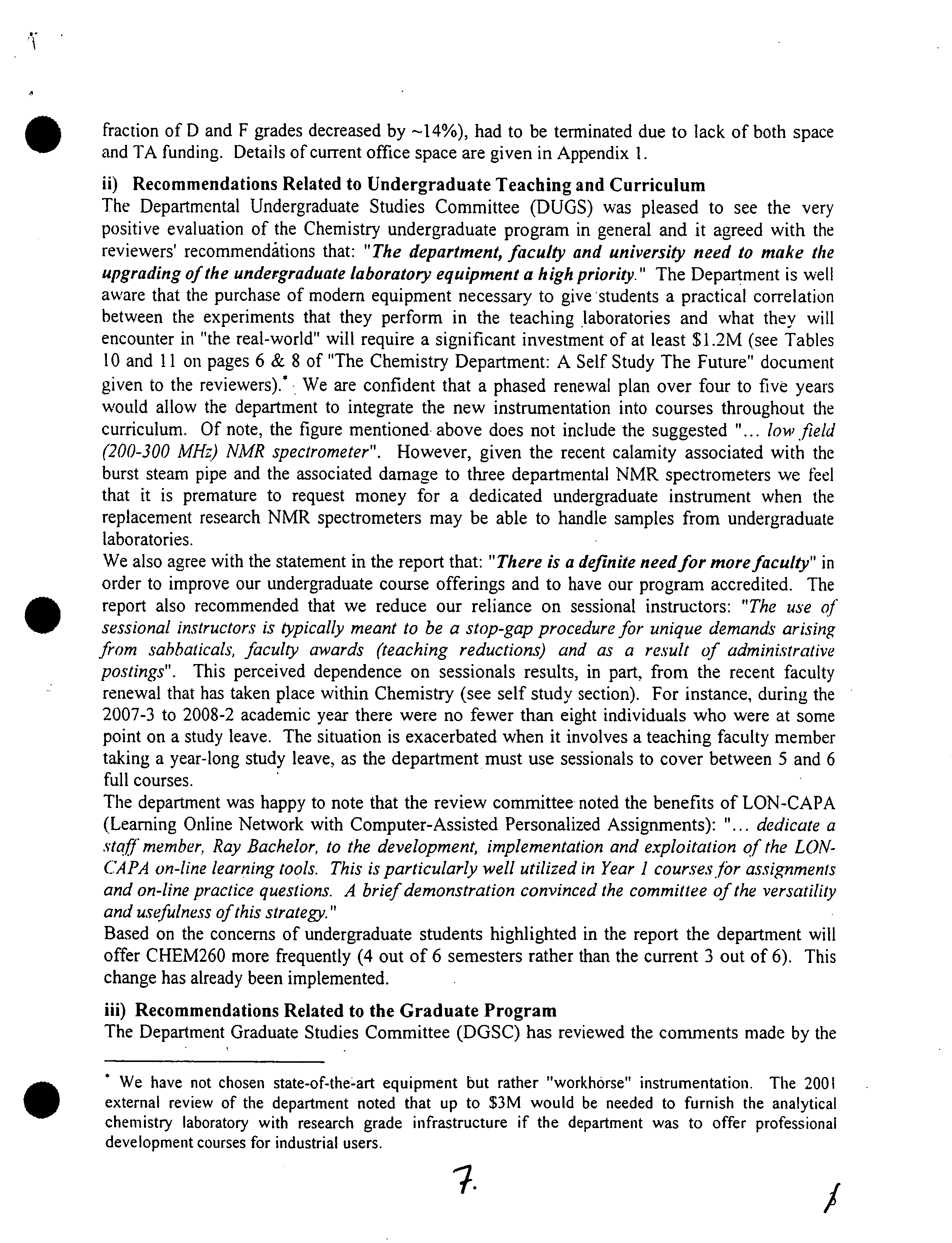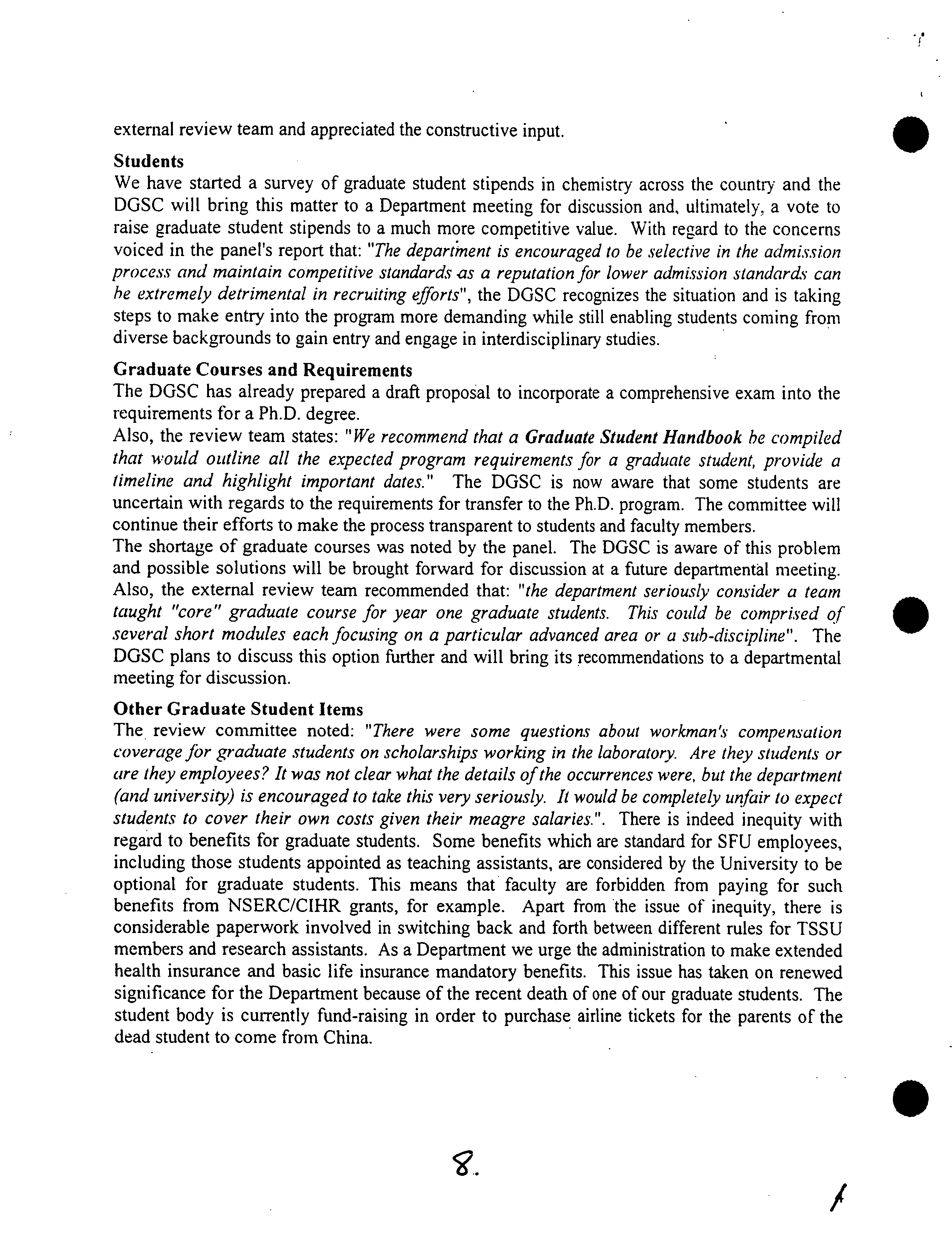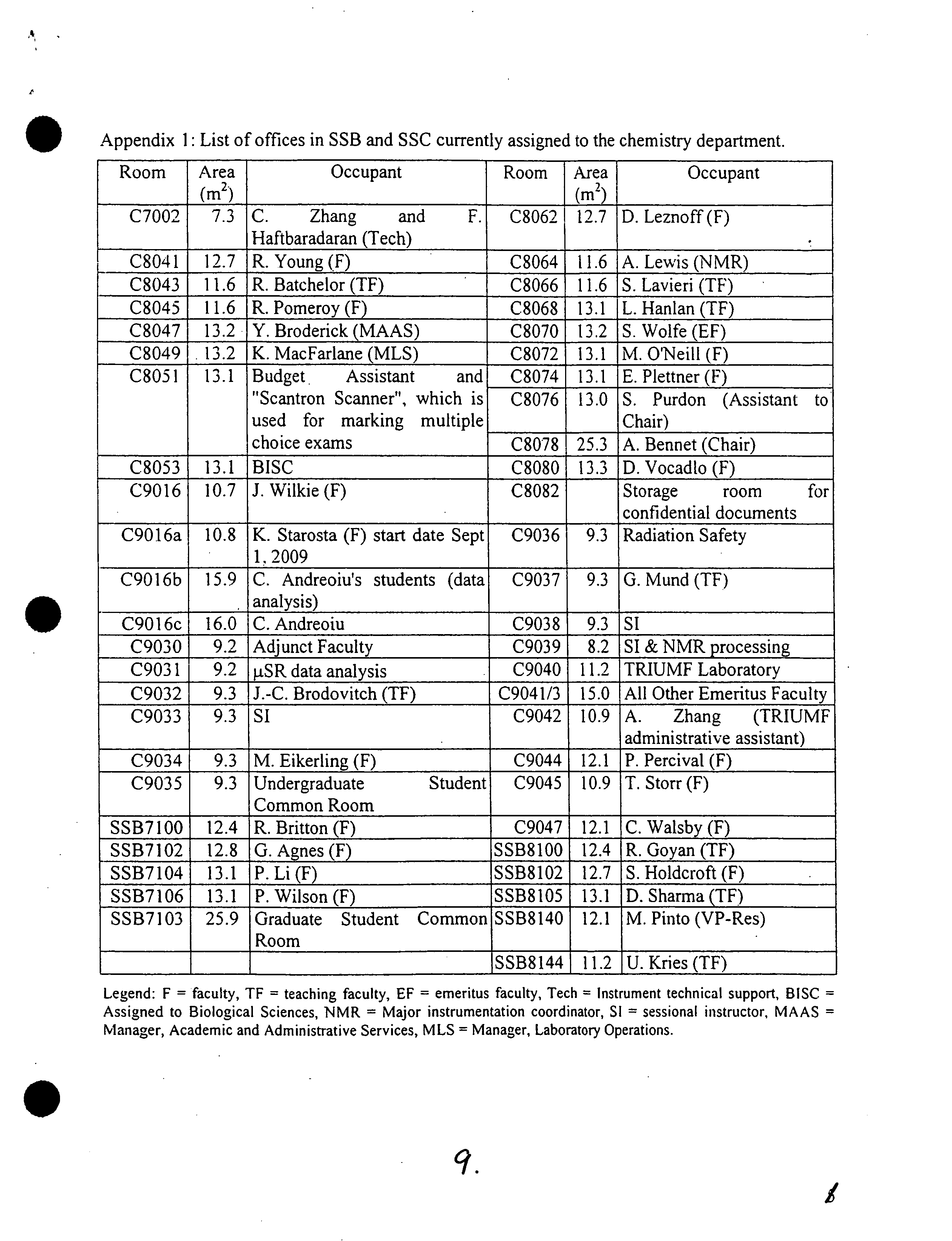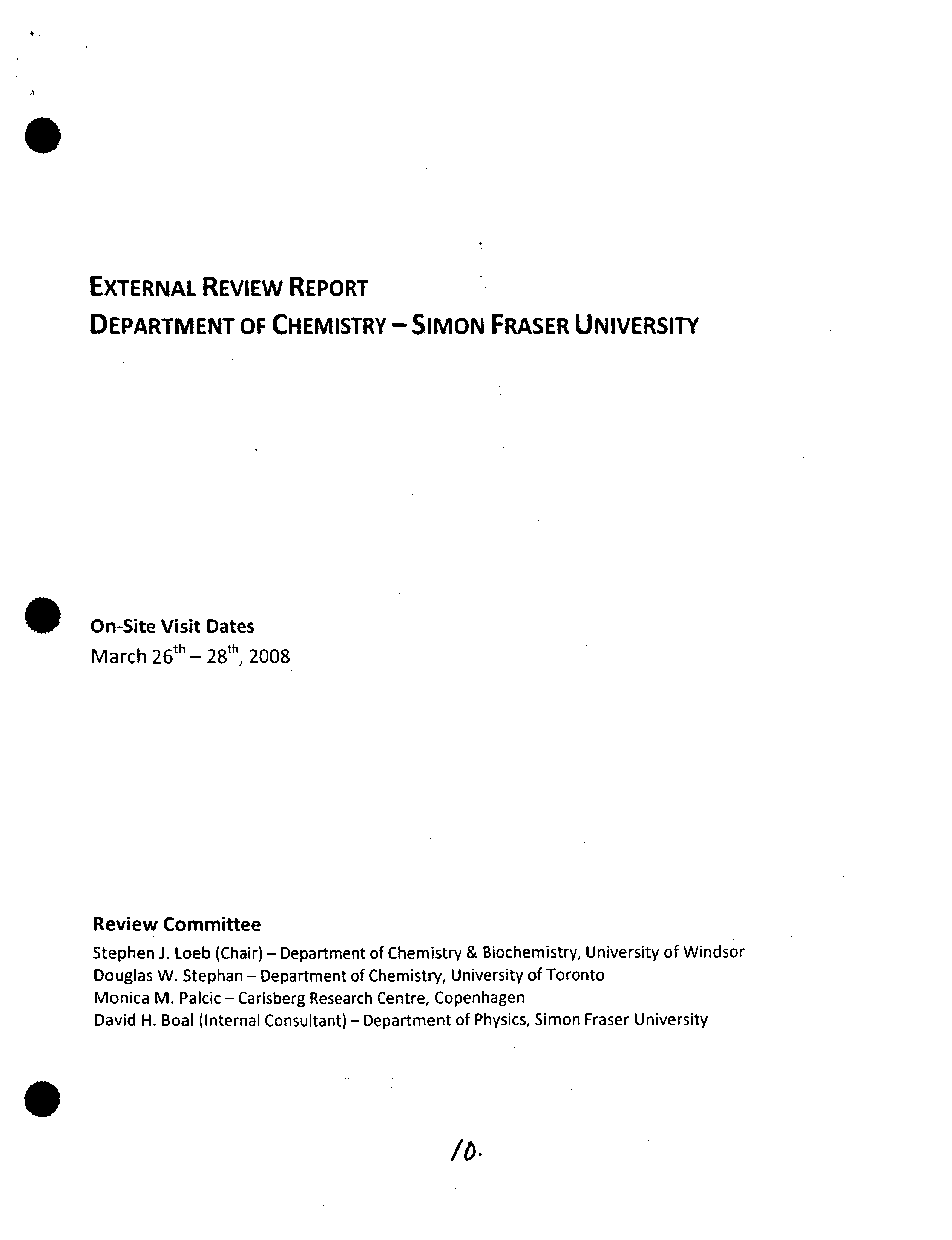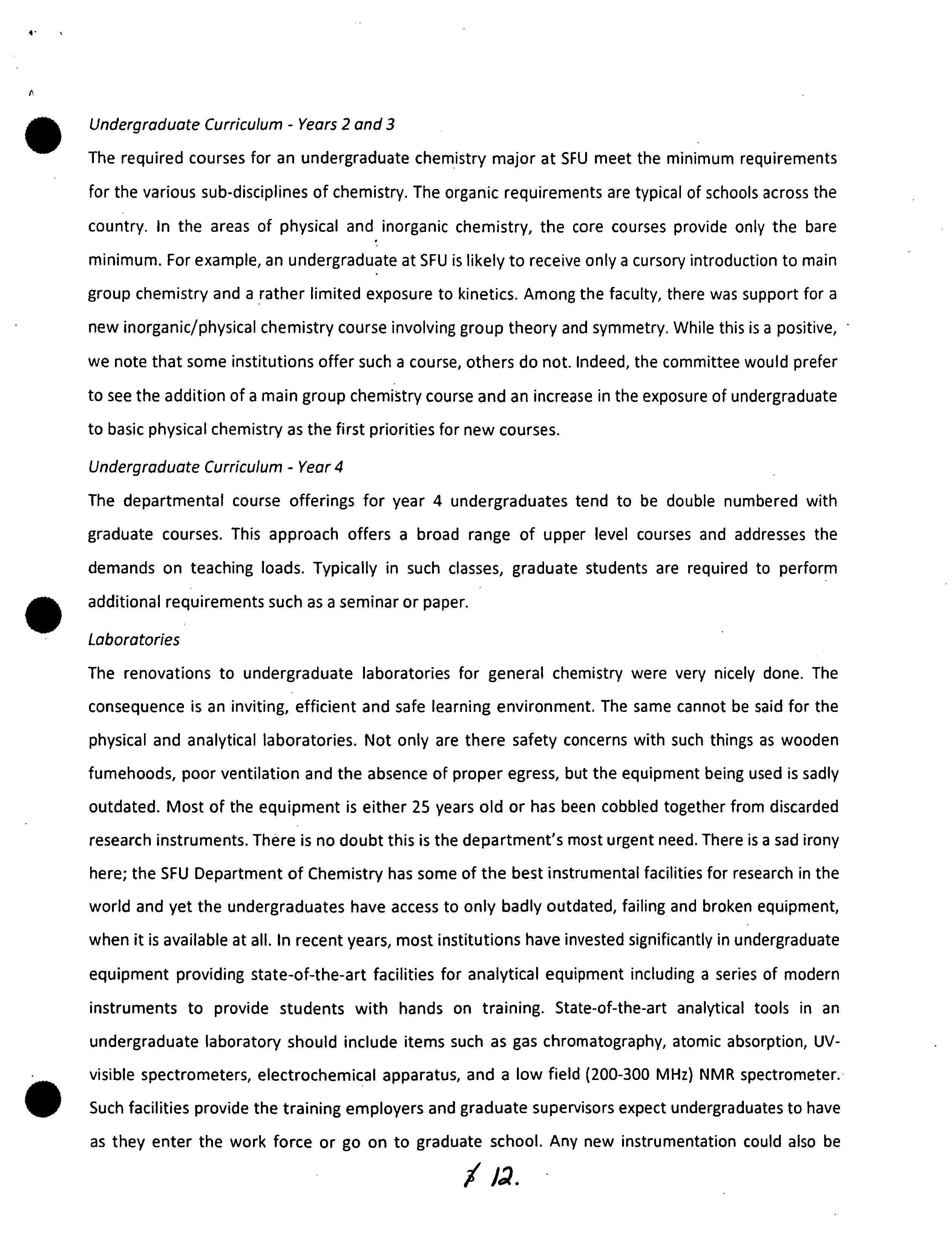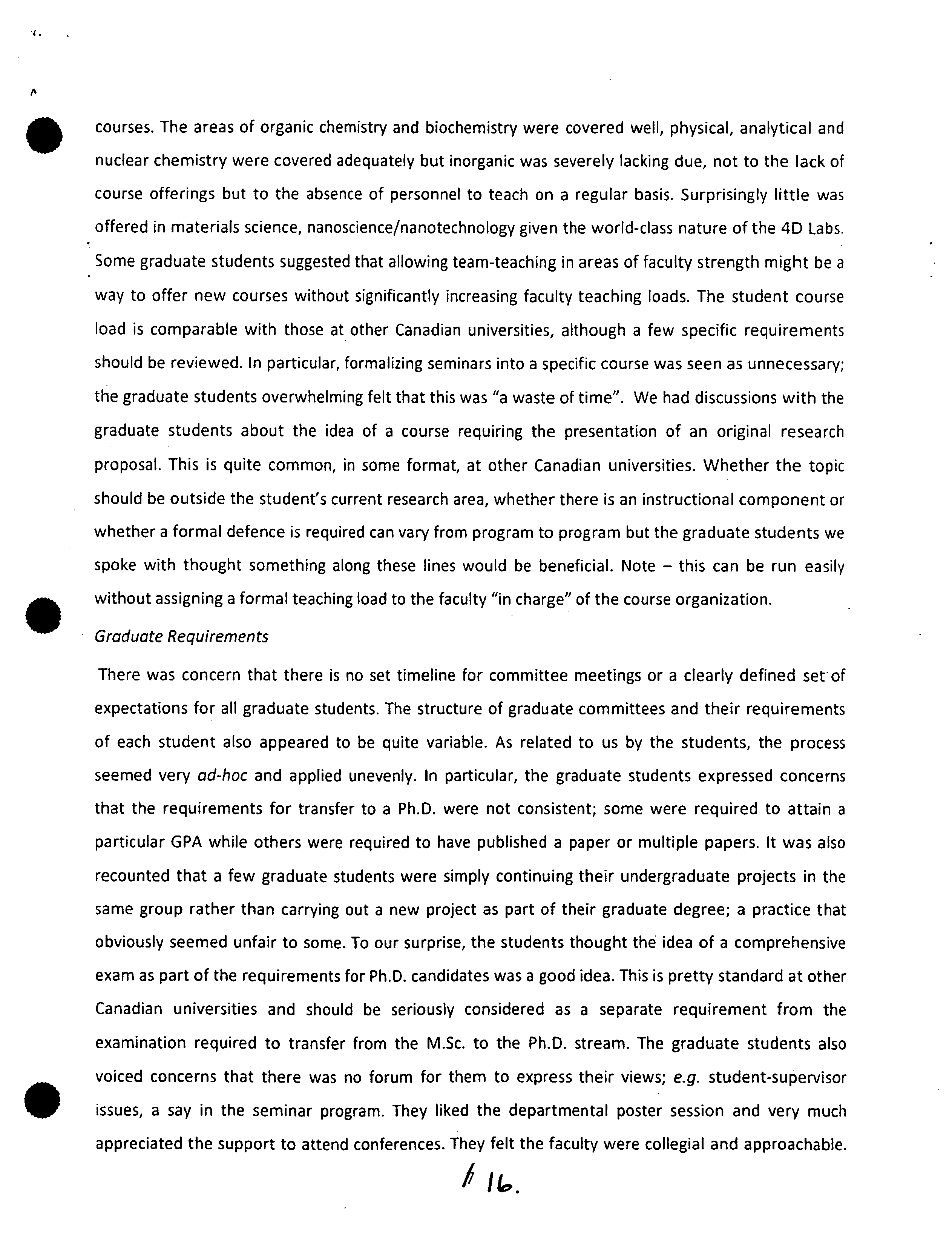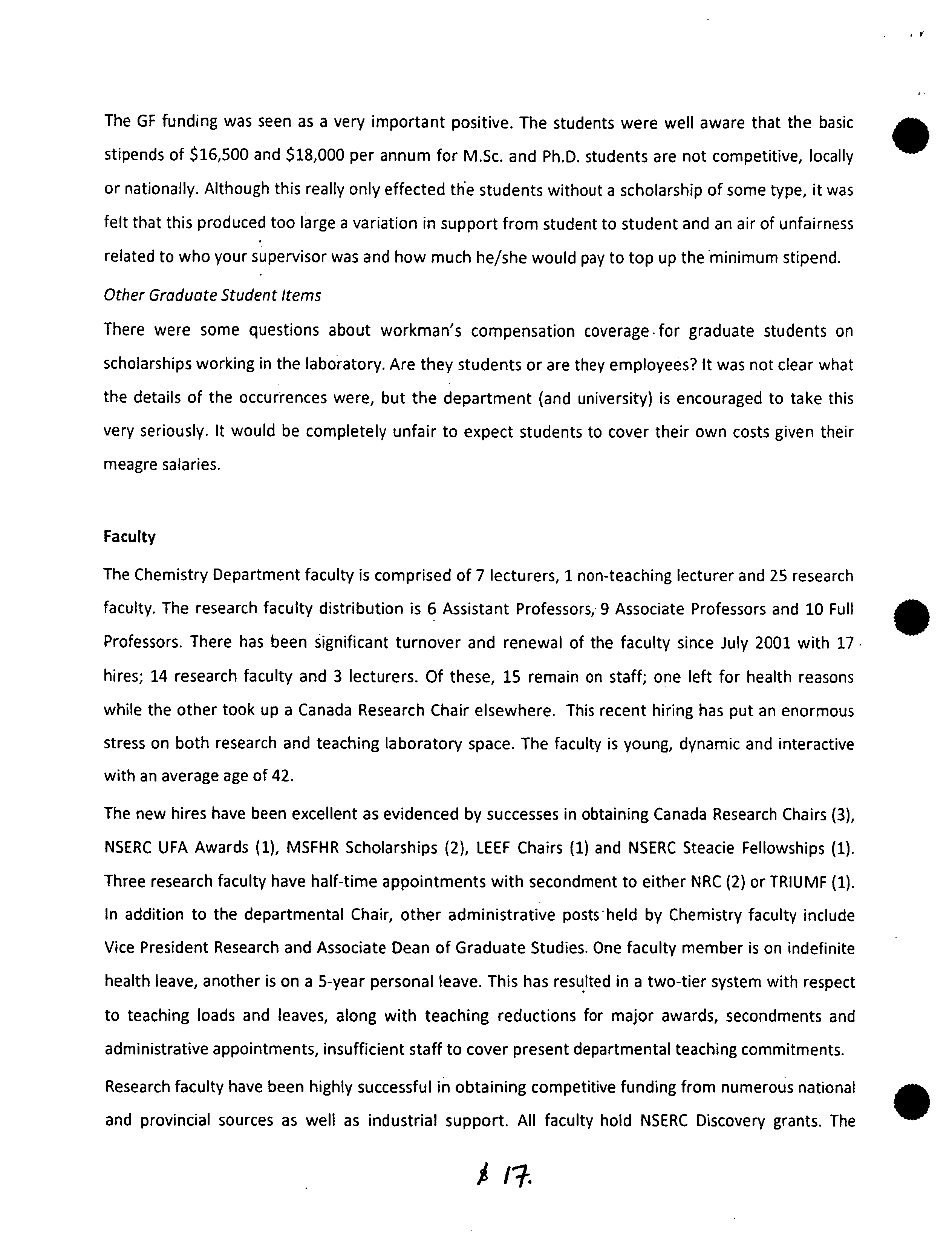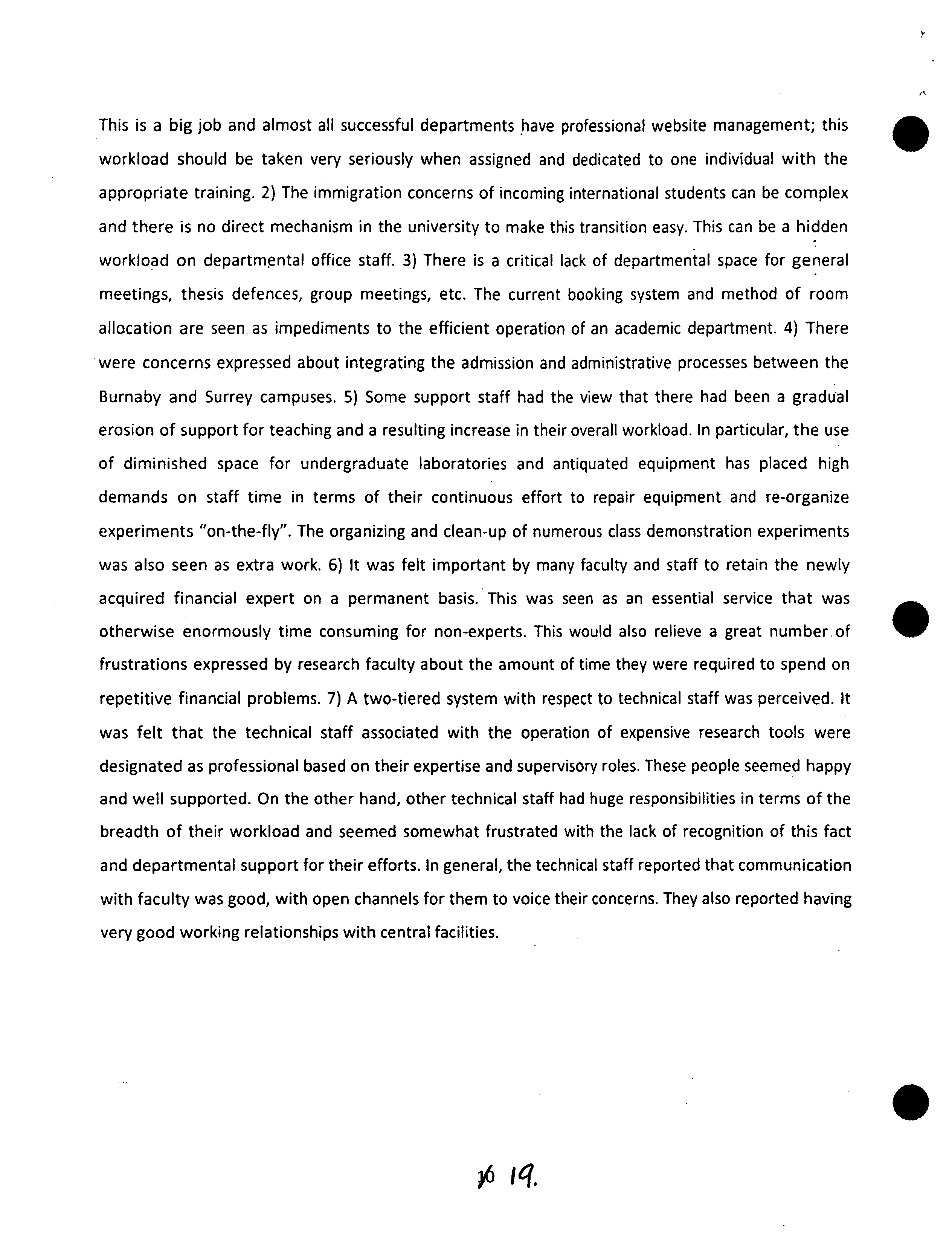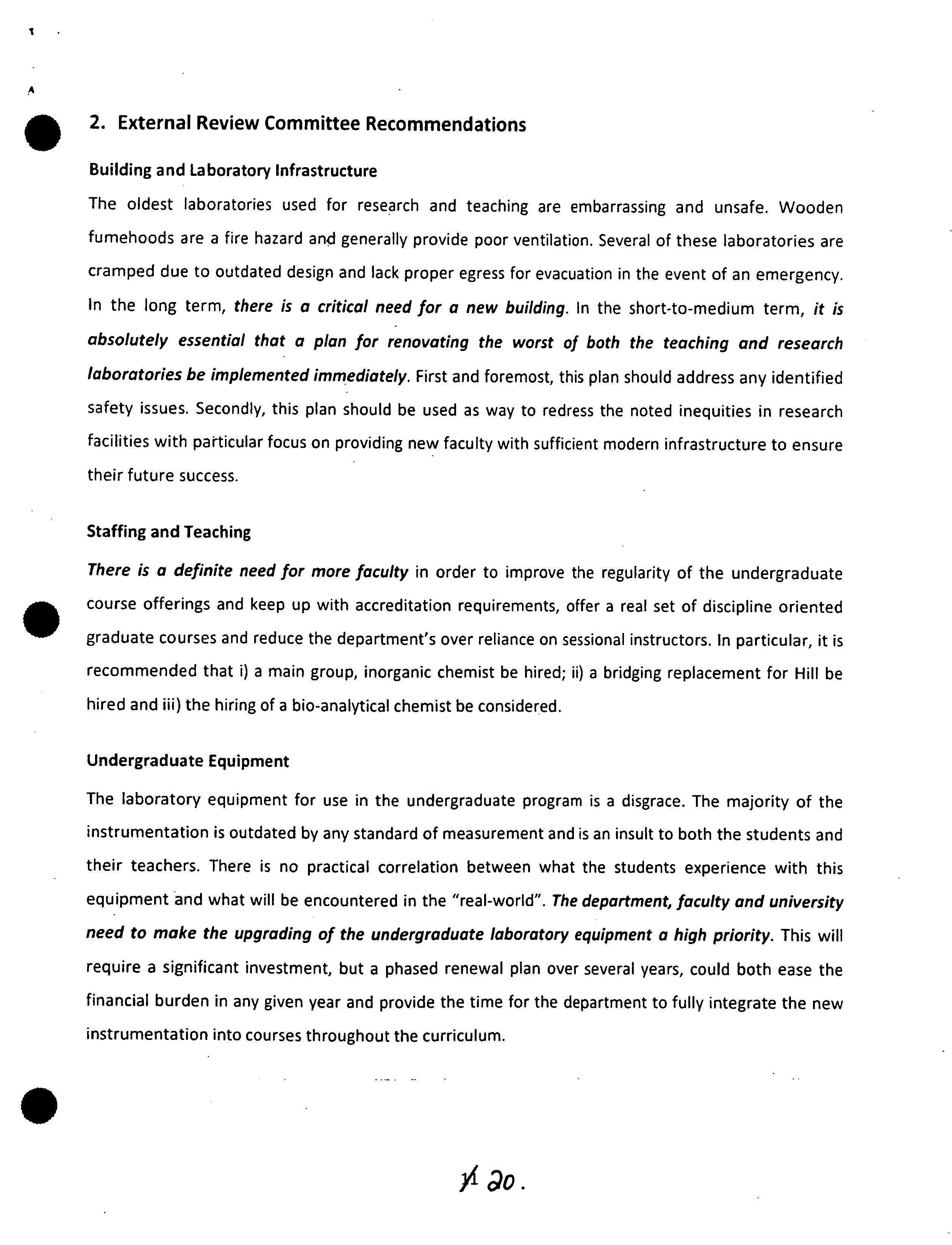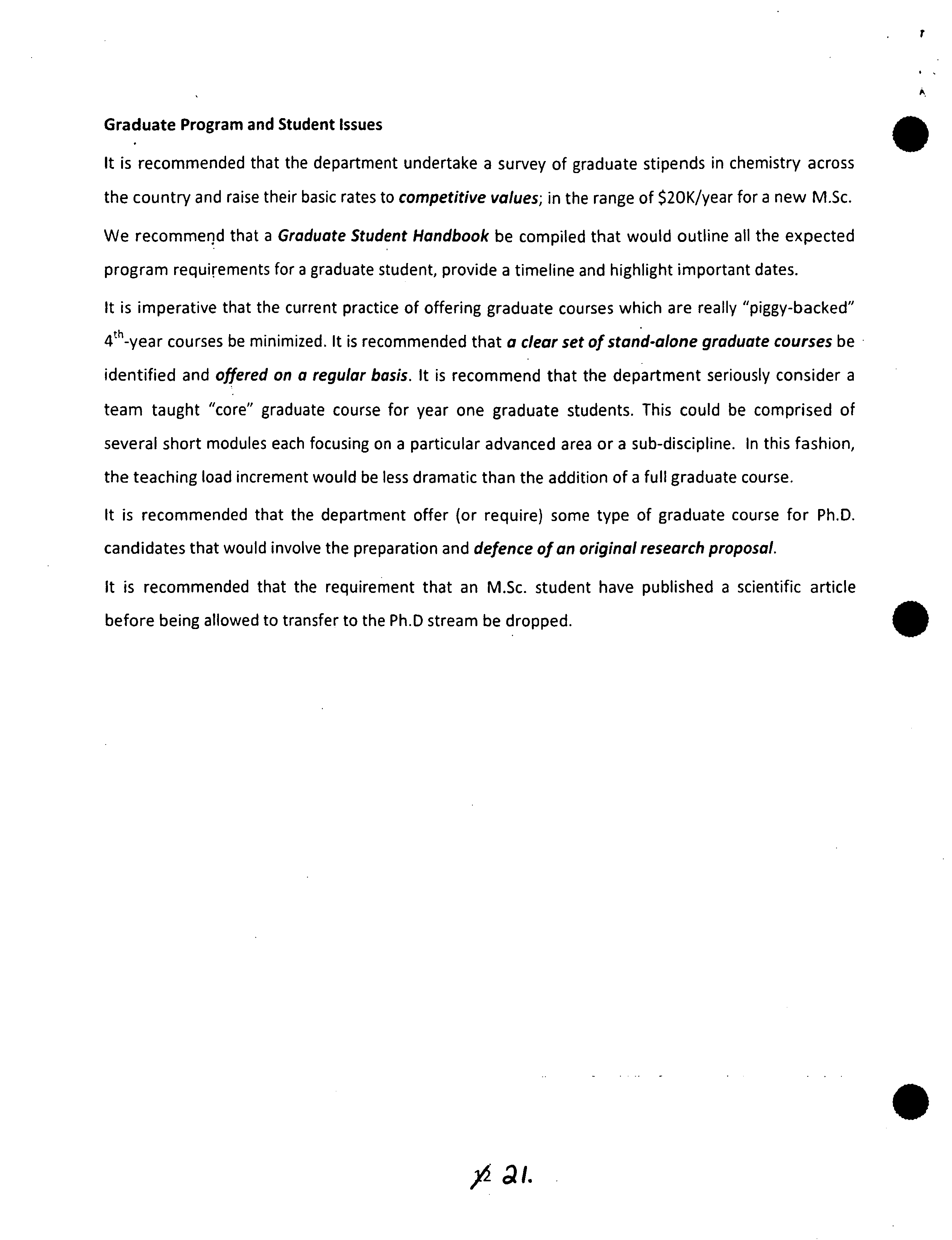S.08-120
SIMON FRASER UNIVERSITY
Senate Committee on University Priorities
?
Memorandum
TO: Senate ?
FROM: ?
Jon Driver
Chair, SCUP and
Vice President, Academic
RE:
Department of Chemistry
?
DATE: ?
October 22, 2Q08
A
The Senate Committee on University Priorities (SCUP ha4 reviewed the External
Review Report on the Department of Chemistry, togetttr v4th responses from the Chair
and Dean of the Faculty of Science, and input from the A
k
S
date Vice President,
Academic.
Motion:
That Senate approve the recommendations from the Senate Committee on
.
?
University Priorities concerning advice to the Department of Chemistry and
the Dean of Science on priority items resulting from the External Review.
The report of the External Review
Team*
for the Department of Chemistry was
submitted in July 2008 following the review team's site visit. The response from the
Department of Chemistry and the response from the Dean were received in August
2008.
The Review Team viewed the Department as a strong department which has made very
good hiring decisions. A number of recommendations were made by the Team which
may further strengthen the Department.
SCUP recommends to Senate that the Department of Chemistry and the Dean
of Science
be advised to pursue the following as priority items.
1. Undergraduate Programmes
• As a priority and with the assistance of the Dean, establish a plan for the
upgrading of equipment in the physical and analytical chemistry laboratories.
• Review the level of dependence on the use of sessional instructors for
•teaching undergraduate courses.
a Review the teaching loads of the continuing faculty.
2.
Graduate Programmes
• Review
avoiding
the
'double
requirements
numbering'
for the
of courses.
B Sc and the MSc degrees with a view to
?
S
• Review the procedures for the admission to the PhD to ensure consistent
application of admission requirements..
• Introduce a graduate course for PhD candidates that includes the preparation
and defense of an original research proposal.
• Review the graduate stipends offered to ensure they are competitive with
other departments of Chemistry across Canada.
• Consider the compilation of a departmental Graduate Student handbook.
3. Faculty
o
Consider with the assistance of the dean, the possibility of increasing the
number of faculty.
4. Administration
• As a priority and with the assistance of the Dean, address the critical safety
issues associated with the Shrum Science Building.
• Continue to seek possible solutions to address the shortage of adequate
space.
* Review Team
Dr. Steven Loeb (Chair) - University of Windsor
Dr. Douglas Stephan - University of Toronto
Dr. Monica Palcic - Carlsberg Research Centre, Copenhagen
CC Mike Plischke, Dean, Faculty Science
Andrew Bennet, Chair, Dept of Chemistry
.
2
-fl
• ___________
?
(RECEIVED
AUG 28 2008
Vice President?
ACADEMIC
TO: Bill Krane, Associate VP
?
FROM:
Dr. Michael Plischke, Dean
Academic
?
Faculty of
Science
RE: External Review of Chemistry DATE:
August 26, 2008
I am writing with respect to the 2008 external review of the Department of Chemistry and the
Department's response, dated August 25, 2008. The Department has either accepted the
recommendations of the review team, or has referred them to the appropriate committee for
further discussion and I therefore have little to add. The report contains a formal
"Recommendation" section but the body of the report also contains some suggestions that are
not reiterated in this summary or addressed in the Department's response. I will highlight a few
of these.
The review is highly complimentary of the quality of the Department's research and teaching
faculty and! completely agree with this opinion. The Chair, Andrew Bennet, and his predecessor,
Mario
Pinto,
are to be congratulated for positioning the Department in such a way that it is
competitive with any in Canada in its areas of strength.
The external review report identified four primary areas of concern: (i) quality of the research
space in the Shrum section of the Science area, (ii) poor quality of equipment in some of the
undergraduate teaching laboratories, (iii) excessive use of sessionals in the teaching program and
(iv)
graduate program organization and resources. I will comment briefly on each of theses.
(j)
q
uality
of Research Space in the Shrum building: There Is no doubt that this space Is
inadequate and potentially unsafe. The University has recognized this and made a new
building for Chemistry one of Its highest priorities. However, relief is probably several years in
the future.
(ii) Under
g
raduate laborator
y
eauioment: This is a situation that must be fixed. I will work
with the Department to formulate a financial plan to refurbish the relevant labs over a two- to
three-year period. The expected cost to bring these labs to an acceptable standard Is around
$1,200,000, a sum not easy to find in these difficult times, However, the review committee
identifies this as the most urgent priority and we will have to address it.
(iii)
Excessive use of session
p
is: There is no doubt in my mind that Chemistry uses an
undesirably high number of sessional instructors. A glance at the position roster of the
Department reveals that there are two vacant positions and three other tenure-track faculty
. with 100% teaching relief. As well, because of secondments (Holdcroft , Eikerling), CRCs
(Branda, Gates, Vocadlo), UFAS (Andreoiu), LEEF Chairs (Young). MSFHR awards (O'Neill),
split and administrative appointments (Agnes, Bennet and Percival) a further eleven tenure
3
track faculty have reduced teaching loads. Therefore, it Is easy to see how we have arrived at
the present state of affairs. While It is not stated In the recommendation section, there is a
clear hint in the text that the Department should have a discussion of whether or not the
current "normal" teaching load, is consistent with the imperative to deliver quality
undergraduate and graduate programs.
(iv) Graduate
p
ro g ram issues: The Department has addressed most of the points raised by
the review committee. Two that have not been addressed are the double-numbering of fourth
year undergraduate courses as graduate courses and the introduction of a comprehensive
examination for Ph.D. candidates. Double-numbering of courses is highly undesirable in my
opinion but is, unfortunately, becoming more common across the Faculty. I have no firm
opinion on the benefits of a comprehensive examination but do recommend that the
Graduate Program Committee consider it.
Michael Plischke
Andy Bennet
S
SIMoN IIoASIIO UNI VkKSI IV
?
THINKING OF THE WORLD
6'.
Response of the Chemistry Department to the Comments and Recommendations of the External?
Review Team Prepared by A.J. Bennet, Chair with Input from Chair's Advisory Committee?
August 25, 2008
1.
Introduction
The Chemistry Department thanks the External Review Team for the time and effort they put into
their analysis and the clear statement of the challenges facing SFU Chemistry. We agree with
most of the recommendations and are working on those that are within our power. Before
responding to specific comments and recommendations we correct a few misunderstandings that
were incorporated in the report from the external review committee.
2. Clarification:
Teaching loads (page 9, also mentioned on pages 4-5):
"The normal teaching load is 2 courses
for research faculty, 4 courses for lecturers
therefore
32 courses can be covered by the research
faculty and 28 by the lecturers."
We try to set a normal teaching load for faculty who do not
have teaching release or major administrative duties to 2Y2 courses per year. The additional half
course results from team teaching of the graduate seminar course CHEM 801 and occasionally
other graduate courses. With regard to the lecturers, the normal teaching load is two courses per
semester for eight out of nine semesters (the ninth semester being for professional development).
Thus, the average teaching load for a lecturer is
51/3
courses per year.
Page 9: "Replacements for Hill and Pomeroy should be sought, but additional research faculty
should not be hired unless NEW laboratory space is available."
It is our understanding that
faculty members who are on an extended medical leave of absence (Pomeroy in this case) cannot
be replaced. Also, when the replacement position for Professor Hill is allowed to be advertised
(currently this position is, as are all others in the department, frozen) the successful candidate will
be housed in the state of the art facilities that are currently assigned to Professor Hill in the
TASC-11 building.
Page 10: "5) Some support staff had the view that there had been a gradual erosion of support for
teaching and a resulting increase in their overall workload. In particular, the use of diminished
.space for undergraduate laboratories and ... ".
It is true that when Professors Branda and
Vocadlo were hired (both as Tier II CRCs) reductions occurred in the teaching spaces allocated to
the analytical/physical and organic teaching laboratories, respectively. However, when the new
TASC-II building was opened the allotted teaching spaces for these vital undergraduate student
laboratories was restored to approximately their historical sizes.
3. Responses to the S
p ecific Comments and Recommendations:
i) Recommendations related to Departmental infrastructure
Laboratories
The Department agrees with the review committee that
"The oldest laboratories used for
?
research and teaching are embarrassing and unsafe. Wooden Jimehoods are afire hazard and
?
generally provide poor ventilation. Several of these laboratories are cramped due to outdated
?
design and lack proper egress for evacuation in the event of an emergenc
y
."
Thus, almost all of?
the laboratories that contain fume hoods in the Shrum Science Centre are unsafe. The notable
?
exceptions are C8024, C8031, and C9013. C8024 is a research laboratory that was renovated
?
. - after the occurrence of a fire. C8031 is an undergraduate teaching laboratory which was
?
renovated at a cost of $1M -- note the comment on page 3 of the report, which states:
"The
?
renovations to undergraduate laboratories for general chemistry were very nicely done. The
/
consequence is an inviting, efficient and safe learning environment". C90 13
was renovated at a
cost of $800K for the synthetic chemist Dr. Robert Britton: this renovation became necessary
when SFU hired Dr. Robert Young as the LEEF chair in Pharmaceutical Genomics and Drug
Discovery as Dr. Young was given the use the synthetic laboratory SSB8148 that was to house
Dr. Britton when Dr
.
. Mario Pinto's research group relocated into the TASC-11 building.
Accordingly, the Department agrees with the review committee that
?
there is
a
critical need
for
a new building.".
With regard to faculty currently housed in the Shrum Science Centre wing, which the review
committee labeled as
"third world standards",
the department is cognizant of the problems with
these laboratories and that the worst laboratories are those used for synthetic chemistry
applications, i.e.. those where the wooden fume hoods are being routinely used for chemical
reactions. The list of faculty for which this situation holds is: Leznoff, Plettner, Pomeroy (when
he is not on medical leave), Storr (starts September 1, 2008), Walsby, Wilson, and Wolfe
(emeritus). In addition, Drs. Agnes, Li, O'Neill and Percival require occasional access to fume
hood facilities. Unfortunately, the cost of removing old fume hoods and replacing them with
modern facilities is extremely expensive (see examples listed above).
It is clear that the committee's recommendation: "...
it is absolutely essential that a plan for
renovating the worst
of
both the teaching and research laboratories be implemented
immediately."
will
require a sizable investment from the University. The department is
committed to doing everything within its power to ensure that all faculty and students are
provided with a safe working environment in addition to the modem infrastructure necessary to
ensure their (and by extension the university's) success. The problem is clear, but the remedy
requires a very significant investment. .
Office Space
The review committee noted (on page 10) that:
"There is a critical lack of departmental space for
general meetings, thesis defences, group meetings, etc. The current booking system and method
of room allocation are seen as impediments to the efficient operation of an academic
department."
The department views this shortage as critical. Unlike other departments
(Biological Sciences and Physics have 4 and 2 various sized meeting rooms, respectively) we
have no space for even small meetings. In addition, we lack the space needed for teaching
assistants to give office hour assistance to undergraduate students. For obvious safety reasons we
actively discourage graduate students from allowing undergraduates to visit them in their
research laboratories. The department would like to correct this deficiency because chemistry is
the central science and many undergraduate programs require their students to have a basic
understanding of general and organic chemistry. It is crucial, as part of the University's current
retention drive, to ensure that students enrolled in the department's "gatekeeper" courses
CHEM120/121 .
(General Chemistry I) and CHEM28I (Organic Chemistry I) are given every
possible resource to help them succeed. As can be seen from the statistics given in the review
document for the year (2007-4 to 2008-1) 1,158 and 685 students enrolled in CHEM120/121 and
CI-IEM 281, respectively. The department opened, with financial support from the Dean for one
semester (2007-3), a "resource centre", an idea borrowed from the undergraduate program at the
University of Windsor. In essence, two of the larger offices in chemistry were set up with
computers and numerous chemistry textbooks for use by first-year undergraduates who were
identified as having problems in CHEMI20/121. These rooms were staffed by two of our best
teaching assistants for 12 hours per week each. However these two offices have now been
assigned to new faculty members and this program, which produced encouraging results (the
1.
/
fraction of D and F grades decreased by -14%), had to be terminated due to lack of both space
and TA funding. Details of current office space are given in Appendix 1.
ii)
Recommendations Related to Undergraduate Teaching and Curriculum
The Departmental Undergraduate Studies Committee (DUOS) was pleased to see the very
positive evaluation of the Chemistry undergraduate program in general and it agreed with the
reviewers' recommendations that:
"The department, faculty and university need to make the
upgrading
of
the undergraduate laboratory equipment a high priority."
The Department is well
aware that the purchase of modern equipment necessary to give students a practical correlation
between the experiments that they perform in the teaching laboratories and what they will
encounter in "the real-world" will require a significant investment of at least $1.2M (see Tables
10 and 11 on pages 6 & 8 of "The Chemistry Department: A Self Study The Future" document
given to the
reviewers).*
We are confident that a phased renewal plan over four to five years
would allow the department to integrate the new instrumentation into courses throughout the
curriculum. Of note, the figure mentioned above does not include the suggested "...
low field
(200-300 MHz) NMR spectrometer".
However, given the recent calamity associated with the
burst steam pipe and the associated damage to three departmental NMR spectrometers we feel
that it is premature to request money for a dedicated undergraduate instrument when the
replacement research NMR spectrometers may be able to handle samples from undergraduate
laboratories.
We also agree with the statement in the report that:
"There is
a
definite
need for more faculty"
in
order to improve our undergraduate course offerings and to have our program accredited. The
. report also recommended that we reduce our reliance on sessional instructors:
"The use of
sessional instructors is typically meant to be a stop-gap procedure for unique demands arising
from sabbaticals, faculty awards (teaching reductions) and as a result of administrative
postings".
This perceived dependence on sessionals results, in part, from the recent faculty
renewal that has taken place within Chemistry (see self study section). For instance, during the
2007-3 to 2008-2 academic year there were no fewer than eight individuals who were at some
point on a study leave. The situation is exacerbated when it involves a teaching faculty member
taking a year-long study leave, as the department must use sessionals to cover between 5 and 6
full courses.
The department was happy to note that the review committee noted the benefits of LON-CAPA
(Learning Online Network with Computer-Assisted Personalized Assignments): "...
dedicate a
staff
member, Ray Bachelor, to the development, implementation and exploitation of the LON-
APA on-line learning tools. This is particularly well utilized in Year 1 courses for assignments
and on-line practice questions. A brief demonstration convinced the committee of the versatility
and usefulness of this strategy."
Based on the concerns of undergraduate students highlighted in the report the department will
offer CHEM260 more frequently (4 out of 6 semesters rather than the current 3 out of 6). This
change has already been implemented.
iii)
Recommendations Related to the Graduate Program
The Department Graduate Studies Committee (DGSC) has reviewed the comments made by the
• We have not chosen state-of-the-art equipment but rather "workhorse" instrumentation. The 2001
external review of the department noted that up to $3M would be needed to furnish the analytical
chemistry laboratory with research grade infrastructure if the department was to offer professional
development courses for industrial users.
-7.
I
Students
external review team and appreciated the constructive input.
?
0
We have started a survey of graduate student stipends in chemistry across the country and the
DGSC will bring this matter to a Department meeting for discussion and, ultimately, a vote to
raise graduate student stipends to a much more competitive value. With regard to the concerns
voiced in the panel's report that: "The department is encouraged to be selective in the admission
process and maintain competitive standards s a reputation for lower admission standards can
he extremely detrimental in recruiting efforts",
the DGSC recognizes the situation and is taking
steps to make entry into the program more demanding while still enabling students coming from
diverse backgrounds to gain entry and engage in interdisciplinary studies.
Graduate Courses and Requirements
The DGSC has already prepared a draft proposal to incorporate a comprehensive exam into the
requirements for a Ph.D. degree.
Also, the review team states: "We recommend that a
Graduate Student Handbook
he compiled
that would outline all the expected program requirements for a graduate student, provide a
limeline and highlight important dates."
The DGSC is now aware that some students are
uncertain with regards to the requirements for transfer to the Ph.D. program. The committee will
continue their efforts to make the process transparent to students and faculty members.
The shortage of graduate courses was noted by the panel. The DGSC is aware of this problem
and possible solutions will be brought forward for discussion at a future departmental meeting.
Also, the external review team recommended that:
"the department seriously consider a team
taught "core" graduate course for year one graduate students. This could be comprised of
several short modules each
.
focusing on a particular advanced area or a sub-discipline".
The
DGSC plans to discuss this option further and will bring its recommendations to a departmental
meeting for discussion.
Other Graduate Student Items
The review committee noted: "There were some questions about workmanv compensation
coverage Jbr graduate students on scholarships working in the laboratory. Are they students or
are they employees? It was not clear what the details of the occurrences were, but the department
('and university) is encouraged to take this very seriously. It would be completely unfair to expect
students to cover their own costs given their meagre salaries.'.
There is indeed inequity with
regard to benefits for graduate students. Some benefits which are standard for SFU employees,
including those students appointed as teaching assistants, are considered by the University to be
optional for graduate students. This means that faculty are forbidden from paying for such
benefits from NSERC/CIHR grants, for example. Apart from 'the issue of inequity, there is
considerable paperwork involved in switching back and forth between different rules for TSSU
members and research assistants. As a Department we urge the administration to make extended
health insurance and basic life insurance mandatory benefits. This issue has taken on renewed
significance for the Department because of the recent death of one of our graduate students. The
student body is currently fund-raising in order to purchase airline tickets for the parents of the
dead student to come from China.
.
/
0 ?
Appendix 1: List of offices in SSB and SSC currently assigned to the chemistry department.
S
Room
Area
(m2)
Occupant
Room
Area
(m2)
Occupant
C7002
7.3
C. ?
Zhang ?
and ?
F.
Haftbaradaran (Tech)
C8062
12.7 D. Leznoff(F)
C8041
12.7 R. Young (F)
C80641 11.6 A. Lewis (NMR)
C8043
11.6 R. Batchelor (TF)
C8066
11.6
S. Lavieri (TF)
C8045
11.6 R. Pomeroy (F)
C8068 13.1 L. Hanlan (TF)
C8047
13.2
Y. Broderick (MAAS)
C8070
13.2 S. Wolfe (EF)
C8049
13.2 K. MacFarlane (MLS)
C8072 13.1 M. O'Neill (F)
C8051
13.1
Budget
.
?
Assistant ?
and
"Scantron Scanner", which is
used ?
for ?
marking ?
multiple
choice exams
C8074 13.1 E. Plettner(F)
C8076 13.0
S. ?
Purdon ?
(Assistant ?
to
Chair)
C8078 25.3 A. Bennet (Chair)
C8053
13.1 BISC
C8080
13.3 D. Vocadlo (F)
C9016
10.7 J. Wilkie (F)
C8082
Storage ?
room
?
for
confidential documents
C9016a
10.8
K. Starosta (F) start date Sept
1.2009
C9036
9.3 Radiation Safety
C9016b
15.9
C. Andreoiu's students (data
analysis)
C9037
9.3
G. Mund (TF)
C9016c
16.0 C. Andreoiu
C9038
9.3
SI
C9030
9.2 Adjunct Faculty
C9039
8.2 1 SI & NMR processing
C903 1
9.2
i.iSR data analysis ?
. C9040 11.2 TRIUMF Laboratory
C9032
9.3 J.-C. Brodovitch (TF)
C9041/3
15.0 All Other Emeritus Faculty
C9033
9.3 SI
C9042
10.9 A. ?
Zhang ?
(TRIUMF
administrative assistant)
C9034
9.3 M. Eikerling (F)
C904412.1 P. Percival (F)
C9035
9.3
Undergraduate ?
Student
Common Room
C9045 10.9 T. Storr (F)
SSB7 100
12.4
R. Britton (F)
C9047
12.1 C. Waisby (F)
SSB7IO2
12.8
G. Agnes (F)
SSB8100 12.4 R.Goyan(TF)
SSB7104
13.1 P.Li(F)
SSB8102 12.7 S. Holdcroft (F)
SSB7106
13.1 P. Wilson (F)
SSB8I05 13.1 D. Sharma (TF)
SSB7 103
25.9 Graduate ?
Student ?
Common
Room
SSB8I40
I
________
12.1 M. Pinto (VP-Res)
SSB8144 1
?
11.2 1 U.Kries(TF)
Legend: F
= faculty,
TF
= teaching faculty,
EF
= emeritus faculty, Tech = Instrument technical support, BISC =
Assigned to Biological Sciences, NMR = Major instrumentation coordinator, SI sessional instructor, MAAS
Manager, Academic and Administrative Services, MLS = Manager, Laboratory Operations.
/
EXTERNAL REVIEW REPORT
DEPARTMENT OF CHEMISTRY - SIMON FRASER UNIVERSITY
.
On-Site Visit Dates
March
26th
-28
1h 2008
Review Committee
Stephen J. Loeb (Chair) - Department of Chemistry & Biochemistry, University of Windsor
Douglas W. Stephan - Department of Chemistry, University of Toronto
Monica M. Palcic - Carlsberg Research Centre, Copenhagen
David H. Boa! (Internal Consultant) - Department of Physics, Simon Fraser University
/O.
Context
Over a three day period, the review committee met with all members of the Department of Chemistry
including teaching and research faculty, support staff and representatives from both the
undergraduate and graduate student population. We toured all the departmental and related facilities
and met with senior administrators involved in overseeing the department at different levels. During
our formal interviews and social sessions, we consistently asked for candid opinions on the state of the
department with respect to a number of major issues related to academic programs and work
environment. We also endeavoured to document any minor concerns that were important to
particular groups or individuals.
This report is divided into two sections. In the first section, we have summarized our observations
under the general headings of 1) Undergraduate Program, 2) Graduate Program, 3) Faculty and
4) Administration. Within each section, we have strived to address how the quality and quantity of
a) the department's academic programs, b) the faculty research, c) the administration of the
department and d) the departmental environment impacts the four areas listed above. In the second
section, we summarize our recommendations with respect to the key points: i) Building and Laboratory•
Infrastructure, ii) Staffing and Teaching, iii) Undergraduate Equipment and iv) Graduate Program and
Student Issues.
1. Overview of Committee Observations
Undergraduate Program
Undergraduate Curriculum - Year 1
The department strives to utilize the best lecturers (research and teaching faculty) in year 1 as a means
to attract and retain chemistry majors, but there was some concern that a large number of the year 1
sections were being taught by sessional lecturers. The department and faculty dedicate a staff
member, Ray Bachelor, to the development, implementation and exploitation of the Lon-Capa on-line
learning tools. This is particularly well utilized in Year 1 courses for assignments and on-line practice
questions. A brief demonstration convinced the committee of the versatility and usefulness of this
strategy.
7/I!.
I.
Undergraduate Curriculum - Years 2 and 3
The required courses for an undergraduate chemistry major at SFU meet the minimum requirements
for the various sub-disciplines of chemistry. The organic requirements are typical of schools across the
country. In the areas of physical and inorganic chemistry, the core courses provide only the bare
minimum. For example, an undergraduate at SFU is likely to receive only a cursory introduction to main
group chemistry and a rather limited exposure to kinetics. Among the faculty, there was support for a
new inorganic/physical chemistry course involving group theory and symmetry. While this is a positive,
we note that some institutions offer such a course, others do not. Indeed, the committee would prefer
to see the addition of a main group chemistry course and an increase in the exposure of undergraduate
to basic physical chemistry as the first priorities for new courses.
Undergraduate Curriculum - Year 4
The departmental course offerings for year 4 undergraduates tend to be double numbered with
graduate courses. This approach offers a broad range of upper level courses and addresses the
demands on teaching loads. Typically in such classes, graduate students are required to perform
additional requirements such as a seminar or paper.
Laboratories
The renovations to undergraduate laboratories for general chemistry were very nicely done. The
consequence is an inviting, efficient and safe learning environment. The same cannot be said for the
physical and analytical laboratories. Not only are there safety concerns with such things as wooden
fumehoods, poor ventilation and the absence of proper egress, but the equipment being used is sadly
outdated. Most of the equipment is either 25 years old or has been cobbled together from discarded
research instruments. There is no doubt this is the department's most urgent need. There is a sad irony
here; the SFU Department of Chemistry has some of the best instrumental facilities for research in the
world and yet the undergraduates have access to only badly outdated, failing and broken equipment,
when it is available at all. In recent years, most institutions have invested significantly in undergraduate
equipment providing state-of-the-art facilities for analytical equipment including a series of modern
instruments to provide students with hands on training. State-of-the-art analytical tools in an
undergraduate laboratory should include items such as gas chromatography, atomic absorption, UV-
visible spectrometers, electrochemical apparatus, and a low field (200-300 MHz) NMR spectrometer.
Such facilities provide the training employers and graduate supervisors expect undergraduates to have
as they enter the work force or go on to graduate school. Any new instrumentation could also be
integrated into other core laboratory courses, specifically organic, inorganic and physical chemistry and
would therefore have a positive impact across the entire curriculum. On the downside, a certain
amount of extra work would be required to modify the laboratory activities in the respective courses
and this is, of course, an expensive proposition.
Student Concerns
The committee met with undergraduate and graduate students who offered a series of both positive
and negative comments on the undergraduate program from the perspectives of both students and
teaching assistants. In general, they seemed pleased with the atmosphere in the department and the
recent renewal of the general chemistry laboratory facilities in particular. On the other hand, they
raised a number of concerns. With regard to the laboratories, students felt there needed to be much
clearer expectations with respect to the marking of reports. They also would like to see faster
feedback, as it seemed multiple reports were submitted before grades were forthcoming, thus
propagating errors through subsequent reports. The strategy of double numbered courses appeared to
limit the offerings available to fourth-year students and there were complaints about the regularity of
senior course. offerings. Students also had a number of complaints about the overuse of sessional
instructors. The complaints tended to be around inferior communication skills and a lack of teaching
experience. Undergraduates complained about the infrequent offering of Chemistry 260 as it is a
prerequisite to numerous other courses. Persistent scheduling conflicts arising from the lack of a
centralized scheduling system was also raised as a significant issue.
Teaching Loads
The teaching complement in SFU chemistry is comprised of research faculty, teaching faculty and
sessional instructors. Research faculty at SFU are required to teach 2 one semester courses over three
semesters each year. This is a load typical of research faculty in chemistry departments at larger
Canadian institutions (e.g. University of British Columbia, University of Alberta or University of
Toronto), but it is somewhat lower than the load at institutions of comparable size. A more typical
teaching load at comparable institutions would be 2 one semester undergraduate courses and one
graduate course over three semesters. Ironically, the teaching complement at SFU is burdened by the
outstanding research success of many of the faculty, which generates well-deserved research positions
that come with teaching reductions. While the intent is clearly to reward excellence in research and we
do not recommend a change in policy, it must be pointed out that at other institutions such situations
are handled differently. At some institutions, no teaching reductions are afforded to research faculty
'/3.
with the exception of awards that specifically mandate them (Killam, Sloan etc). At other institutions,
teaching reductions to a minimum of 2 one semester courses over three semesters are afforded to
Canada Research Chairs, University Professors and those holding significant administrative positions.
The teaching faculty provides lectures and oversees laboratory activities. Teachings loads are typically
double that of research faculty members. The appointment of such staff are common at many
institutions as a strategy to deal with increased teaching demands without increasing the teaching
loads of research faculty or creating further demands for research space. In this regard, SFU was one of
the first institutions to utilize this concept and has done so with excellent success. The teaching staff at
SFU have proven that the appointment of dedicated, highly qualified personnel who have teaching
experience and are enthusiastic about teaching is an excellent strategy. This is repeatedly reflected in
their teaching evaluations.
The use of sessional instructors is typically meant to be a stop-gap procedure for unique demands
arising from sabbaticals, faculty awards (teaching reductions) and as a result of administrative postings.
SFU faculty in chemistry have been particularly successful in garnering awards and administrative posts
and as a result the department of chemistry has generated a perennial need for a large number of
sessional instructors. This is an abnormally high number of sessional instructors relative to situations at
most other institutions. The use of regular research or teaching faculty is much more desirable.
The Trimester System
A fundamentally unique feature of the course offerings at SFU is the tn-semester system which
provides students with flexibility in terms of schedule. On the other hand, it creates some unique
problems with respect to teaching loads and the range of upper level course selections in any given
term. As a consequence, the department is forced to walk a very thin line between increased teaching
loads and disenchanted students unable to take courses in a timely fashion. This balancing act is not
always successful and is a major source of student frustration.
Graduate Program
Students
There has been steep increase in the number of graduate students in chemistry over the past few
years from 48 in 2001 to a high of 128 in 2008; the present total is approximately 110. This is a result of
hiring excellent new faculty and their success as new researchers. As these new faculty members bring
in an increase in external funding, there has been an increased need for graduate researchers. The
reputation of some researchers coupled with fairly aggressive recruiting has resulted in the attraction
of more graduate students. This is significant since competing with the University of British Columbia
for the same cohort of undergraduates in the same geographic location has always been difficult.
Although this is not likely to change, the department of chemistry at SFU has done an excellent job of
positioning themselves as a viable alternative. This is, of course, critically dependent on the areas of
study available. The creation of two distinct research groups of significant critical mass in terms of
manpower, resources and reputation has helped the department distinguish itself in the areas of
Materials Science and Chemical & Structural Biology. The majority of the graduate students study in
these two areas. Historically, the Nuclear Chemistry program has a positive reputation and there has
been an effort to hire faculty with thisexpertise. It was not clear that, recruitment for this program has
had the same success and it is likely that attracting new students to this program will remain difficult.
Although the numbers have increased and despite the superb accomplishments of some recent
graduates, it is not clear that the overall quality of the present cohort of students is high. A number of
faculty voiced the opinion that the overall quality of the present graduate student population was not
as good as it could be. We may have been hearing a repeat of the same anecdotal stories but this was
not an isolated view. The faculty would like to see an increased emphasis on attracting more
scholarship students. The department is encouraged to be selective in the admission process and
maintain competitive standards as a reputation for lower admission standards can be extremely
detrimental in recruiting efforts.
Graduate Courses
There was universal concern, from both students and faculty, about the number, quality and variety of
the graduate course offerings available. The great majority of the graduate courses were "piggy-
backed" as senior undergraduate courses. The overwhelming view of the graduate students was that
they were participating in undergraduate courses, even if there was a slightly different workload
requirement. Most students who were graduates of another Canadian university said they had taken
the materials already and wanted to learn something in their new chosen area but could not take
courses specific to their needs. More disturbing perhaps, were the numerous reports from graduate
students who obtained their B.Sc. degree at SFU, who said they were forced to take courses they had
already completed as undergraduates due to the lack of choice. In terms of content, the graduate
courses available seemed to mirror the number and availability of research faculty to teach the
j5•
IN
courses. The areas of organic chemistry and biochemistry were covered well, physical, analytical and
nuclear chemistry were covered adequately but inorganic was severely lacking due, not to the lack of
course offerings but to the absence of personnel to teach on a regular basis. Surprisingly little was
offered in materials science, nanoscience/nanotechnology given the world-class nature of the 4D Labs.
Some graduate students suggested that allowing team-teaching in areas of faculty strength might be a
way to offer new courses without significantly increasing faculty teaching loads. The student course
load is comparable with those at other Canadian universities, although a few specific requirements
should be reviewed. In particular, formalizing seminars into a specific course was seen as unnecessary;
the graduate students overwhelming felt that this was "a waste of time". We had discussions with the
graduate students about the idea of a course requiring the presentation of an original research
proposal. This is quite common, in some format, at other Canadian universities. Whether the topic
should be outside the student's current research area, whether there is an instructional component or
whether a formal defence is required can vary from program to program but the graduate students we
spoke with thought something along these lines would be beneficial. Note - this can be run easily
•
?
without assigning a formal teaching load to the faculty "in charge" of the course organization.
Graduate Requirements
There was concern that there is no set timeline for committee meetings or a clearly defined set-of
expectations for all graduate students. The structure of graduate committees and their requirements
of each student also appeared to be quite variable. As related to us by the students, the process
seemed very
ad-hoc
and applied unevenly. In particular, the graduate students expressed concerns
that the requirements for transfer to a Ph.D. were not consistent; some were required to attain a
particular GPA while others were required to have published a paper or multiple papers. It was also
recounted that a few graduate students were simply continuing their undergraduate projects in the
same group rather than carrying out a new project as part of their graduate degree; a practice that
obviously seemed unfair to some. To our surprise, the students thought the idea of a comprehensive
exam as part of the requirements for Ph.D. candidates was a good idea. This is pretty standard at other
Canadian universities and should be seriously considered as a separate requirement from the
examination required to transfer from the M.Sc. to the Ph.D. stream. The graduate students also
voiced concerns that there was no forum for them to express their views;
e.g.
student-supervisor
issues, a say in the seminar program. They liked the departmental poster session and very much
appreciated the support to attend conferences. They
/ I
felt
I,
the faculty were collegial and approachable.
The GF funding was seen as a very important positive. The students were well aware that the basic
stipends of $16,500 and $18,000 per annum for M.Sc. and Ph.D. students are not competitive, locally
or nationally. Although this really only effected the students without a scholarship of some type, it was
felt that this produced too large a variation in support from student to student and an air of unfairness
related to who your supervisor was and how much he/she would pay to top up the minimum stipend.
Other Graduate Student Items
There were some questions about workman's compensation coverage-for graduate students on
scholarships working in the laboratory. Are they students or are they employees? It was not clear what
the details of the occurrences were, but the department (and university) is encouraged to take this
very seriously. It would be completely unfair to expect students to cover their own costs given their
meagre salaries.
Faculty
The Chemistry Department faculty is comprised of 7 lecturers, 1 non-teaching lecturer and 25 research
faculty. The research faculty distribution is 6 Assistant Professors,' 9 Associate Professors and 10 Full
Professors. There has been significant turnover and renewal of the faculty since July 2001 with 17.
hires; 14 research faculty and 3 lecturers. Of these, 15 remain on staff; one left for health reasons
while the other took up a Canada Research Chair elsewhere. This recent hiring has put an enormous
stress on both research and teaching laboratory space. The faculty is young, dynamic and interactive
with an average age of 42.
The new hires have been excellent as evidenced by successes in obtaining Canada Research Chairs (3),
NSERC UFA Awards (1), MSFHR Scholarships (2), LEEF Chairs (1) and NSERC Steacie Fellowships (1).
Three research faculty have half-time appointments with secondment to either NRC (2) or TRIUMF (1).
In addition to the departmental Chair, other administrative postsheld by Chemistry faculty include
Vice President Research and Associate Dean of Graduate Studies. One faculty member is on indefinite
health leave, another is on a 5-year personal leave. This has resulted in a two-tier system with respect
to teaching loads and leaves, along with teaching reductions for major awards, secondments and
administrative appointments, insufficient staff to cover present departmental teaching commitments.
Research faculty have been highly successful in obtaining competitive funding from numerous national
and provincial sources as well as industrial support. All faculty hold NSERC Discovery grants. The
department funding levels are above the national averages for the traditional Chemistry Panels; GSC 24
and GSC 26. There are internationally recognized teams in Materials Science and Chemical & Structural
Biology. The materials group is a model for interactive research that crosses disciplines and
departments. While most members of these teams have state-of-the art laboratories in the newly
constructed TASC2 building (4D LABS, the GlyoScience Centre) or in refurbished laboratories,
numerous other research laboratories approach "third world" standards. For example, one can
contrast the laboratories of Profs. Gates, Britton or Vocadlo with those of O'Neill, Andreoiu or Plettner.
This two-tier structure with respect to quality (or not) of research laboratory space requires urgent
attention given the needs for young investigators to establish their research programs and attract
graduate students.
The normal teaching load is 2 courses for research faculty, 4 courses for lecturers therefore 32 courses
can be covered by the research faculty and 28 by the lecturers. This is not sufficient to cover the
courses offered by the department. This has resulted in heavy use of sessional instructors, a short-term
but economical solution. Replacements for Hill and Pomeroy should be sought, but additional research
faculty should not be hired unless NEW laboratory space is available.
It was suggested that 'a formalized mentorihg for junior faculty could be arranged with focus on items
such as group management, graduate admissions, publication strategies, etc. This has usually been left
to each individual and their respective peer groups to implement. This strategy has been excellent in
some areas but lacking in others for various reasons. Formalization of this effort might alleviate some
of the discrepancies by providing everyone with the same advice whether it is felt they needed it or
not.
Administration
The Department of Chemistry is clearly involved in the administration of the university placing faculty
in positions such as vice-president research and associate dean of graduate studies. Internally, the
department has a solid committee structure and does a very good job of involving faculty and staff at
all levels. It was especially gratifying to see serious participation from teaching and research faculty as
well as technical and administrative staff. Overall, the department moral was seen as very good.
• A few concerns were expressed by individuals. 1) The webpage is a very important tool for the
dissemination of information both internally and externally. The "face" of the department on the web
needs to be accurate and up to date as this is also an important recruiting tool for today's students.
1J
This is a big job and almost all successful departments have professional website management; this
workload should be taken very seriously when assigned and dedicated to one individual with the
appropriate training. 2) The immigration concerns of incoming international students can be complex
and there is no direct mechanism in the university to make this transition easy. This can be a hidden
workload on departmental office staff. 3) There is a critical lack of departmental space for general
meetings, thesis defences, group meetings, etc. The current booking system and method of room
allocation are seen, as impediments to the efficient operation of an academic department. 4) There
were concerns expressed about integrating the admission and administrative processes between the
Burnaby and Surrey campuses. 5) Some support staff had the view that there had been a gradual
erosion of support for teaching and a resulting increase in their overall workload. In particular, the use
of diminished space for undergraduate laboratories and antiquated equipment has placed high
demands on staff time in terms of their continuous effort to repair equipment and re-organize
experiments "on-the-fly". The organizing and clean-up of numerous class demonstration experiments
was also seen as extra work. 6) It was felt important by many faculty and staff to retain the newly
acquired financial expert on a permanent basis. This was seen as an essential service that was
for
otherwise enormously time consuming ?
non-experts. This would also relieve a great number.of
frustrations expressed by research faculty about the amount of time they were required to spend on
repetitive financial problems. 7) A two-tiered system with respect to technical staff was perceived. It
was felt that the technical staff associated with the operation of expensive research tools were
designated as professional based on their expertise and supervisory roles. These people seemed happy
and well supported. On the other hand, other technical staff had huge responsibilities in terms of the
breadth of their workload and seemed somewhat frustrated with the lack of recognition of this fact
and departmental support for their efforts. In general, the technical staff reported that communication
with faculty was good, with open channels for them to voice their concerns. They also reported having
very good working relationships with central facilities.
.
i6iq.
A
0
2. External Review Committee Recommendations
Building and Laboratory Infrastructure
The oldest laboratories used for research and teaching are embarrassing and unsafe. Wooden
fumehoods are a fire hazard and generally provide poor ventilation. Several of these laboratories are
cramped due to outdated design and lack proper egress for evacuation in the event of an emergency.
In the long term,
there is a critical need for a new building.
In the short-to-medium term,
it is
absolutely essential that a plan for
renovating the worst
of both the teaching and research
laboratories be implemented immediately.
First and foremost, this plan should address any identified
safety issues. Secondly, this plan should be used as way to redress the noted inequities in research
facilities with particular focus on providing new faculty with sufficient modern infrastructure to ensure
their future success.
Staffing and Teaching
There
is a definite need for
more faculty
in order to improve the regularity of the undergraduate
• course offerings and keep up with accreditation requirements, offer a real set of discipline oriented
graduate courses and reduce the department's over reliance on sessional instructors. In particular, it is
recommended that i) a main group, inorganic chemist be hired; ii) a bridging replacement for Hill be
hired and iii) the hiring of a bio-analytical chemist be considered.
Undergraduate Equipment
The laboratory equipment for use in the undergraduate program is a disgrace. The majority of the
instrumentation is outdated by any standard of measurement and is an insult to both the students and
their teachers. There is no practical correlation between what the students experience with this
equipment and what will be encountered in the "real-world".
The
department, faculty and university
need to make the upgrading
of the undergraduate laboratory equipment a high priority.
This will
require a significant investment, but a phased renewal plan over several years, could both ease the
financial burden in any given year and provide the time for the department to fully integrate the new
instrumentation into courses throughout the curriculum.
.
YcO.
A
Graduate Program and Student Issues
It is recommended that the department undertake a survey of graduate stipends in chemistry across
the country and raise their basic rates to
competitive values;
in the range of $20K/year for a new M.Sc.
We recommend that a
Graduate Student Handbook
be compiled that would outline all the expected
program requirements for a graduate student, provide a timeline and highlight important dates.
It is imperative that the current practice of offering graduate courses which are really "piggy-backed"
4
th
year courses be minimized. It is recommended that
a clear set of
stand-alone graduate courses
be
identified and
offered on a regular basis.
It is recommend that the department seriously consider a
team taught "core" graduate course for year one graduate students. This could be comprised of
several short modules each focusing on a particular advanced area or a sub-discipline. In this fashion,
the teaching load increment would be less dramatic than the addition of a full graduate course.
It is recommended that the department offer (or require) some type of graduate course for Ph.D.
candidates that would involve the preparation and
defence
of
an original research proposal.
It is recommended that the requirement that an M.Sc. student have published a scientific article
before being allowed to transfer to the Ph.D stream be dropped.
.
Xai.


